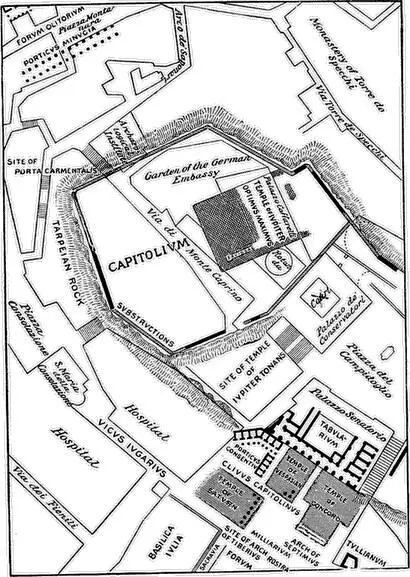Rodolfo Amedeo Lanciani - Pagan and Christian Rome
Здесь есть возможность читать онлайн «Rodolfo Amedeo Lanciani - Pagan and Christian Rome» — ознакомительный отрывок электронной книги совершенно бесплатно, а после прочтения отрывка купить полную версию. В некоторых случаях можно слушать аудио, скачать через торрент в формате fb2 и присутствует краткое содержание. Жанр: foreign_edu, История, История, на английском языке. Описание произведения, (предисловие) а так же отзывы посетителей доступны на портале библиотеки ЛибКат.
- Название:Pagan and Christian Rome
- Автор:
- Жанр:
- Год:неизвестен
- ISBN:нет данных
- Рейтинг книги:3 / 5. Голосов: 1
-
Избранное:Добавить в избранное
- Отзывы:
-
Ваша оценка:
- 60
- 1
- 2
- 3
- 4
- 5
Pagan and Christian Rome: краткое содержание, описание и аннотация
Предлагаем к чтению аннотацию, описание, краткое содержание или предисловие (зависит от того, что написал сам автор книги «Pagan and Christian Rome»). Если вы не нашли необходимую информацию о книге — напишите в комментариях, мы постараемся отыскать её.
Pagan and Christian Rome — читать онлайн ознакомительный отрывок
Ниже представлен текст книги, разбитый по страницам. Система сохранения места последней прочитанной страницы, позволяет с удобством читать онлайн бесплатно книгу «Pagan and Christian Rome», без необходимости каждый раз заново искать на чём Вы остановились. Поставьте закладку, и сможете в любой момент перейти на страницу, на которой закончили чтение.
Интервал:
Закладка:

The family of Augustus. Relief from the Ara Pacis, in the Gallery of the Uffizi, Florence.
Ara Incendii Neroniani. In the month of July, a. d. 65, half Rome was destroyed by the fire of Nero. The citizens, overwhelmed by the greatness of the calamity, and ignorant of its true cause, made a vow for the annual celebration of expiatory sacrifices, on altars expressly constructed for the purpose in each of the fourteen regions of the metropolis. The vow was, however, forgotten until Domitian claimed its fulfilment some twenty or twenty-five years later. One of these altars, which adjoined Domitian's paternal house on the Quirinal, has just been found near the church of S. Andrea del Noviziato, in the foundations of the new "Ministero della Casa Reale."
The altar, six metres long by three wide, built of travertine with a coating of marble, stands in the middle of a paved area of considerable size. The area is lined with stone cippi, placed at an interval of two and a half metres from one another. The following inscription has been found engraved on two of them: "This sacred area, marked with stone cippi, and enclosed with a hedge, as well as the altar which stands in the middle of it, was dedicated by the emperor Domitian in consequence of an unfulfilled vow made by the citizens at the time of the fire of Nero. The dedication is made subject to the following rules: that no one shall be allowed to loiter, trade, build, or plant trees or shrubs within the line of terminal stones; that on August 23 of each year, the day of the Volkanalia, the magistrate presiding over this sixth region shall sacrifice on this altar a red calf and a pig; that he shall address to the gods the following prayer (text missing)." The inscription has been read twice: once towards the end of the fifteenth century, when the cippus containing it was removed to S. Peter's and made use of in the new building, and again in 1644, when Pope Barberini was laying the foundations of S. Andrea al Quirinale, one of the most graceful and pleasing churches of modern Rome.
Let us now turn our attention to more imposing structures. The first temple in the excavation of which I took part was that of Jupiter Optimus Maximus on the Capitoline Hill. 48Its discovery was due more to an intuition of the truth, than to actual recognition of existing remains. On November 7, 1875, while digging for the foundation of the new Rotunda in the garden which divides the Conservatori palace from that of the Caffarellis,—the residence of the German ambassador,—our workmen came upon a piece of a colossal fluted column of Pentelic marble, lying on a platform of squared stones, which were laid without mortar, in a decidedly archaic style. Were we in the presence of the remains of the famous Capitolium, or of one of the smaller temples within the Arx? To give this query a satisfactory answer, we must remember that the Capitoline Hill had two summits, one containing the citadel, or Arx, the other the Temple of Jupiter Optimus Maximus, the Capitolium. Ancient writers never use the two names promiscuously, or apply them indifferently to either summit or to the whole hill. The name of the hill is the Capitoline ; not the Capitol , which means exclusively the portion occupied by the great temple. Suffice it to quote Livy's evidence (vi. 20), ne quis in Arce aut Capitolio habitaret , and also the passage of Aulus Gellius (v. 12) in which the shrine of Vedjovis is placed between the Arx and the Capitolium.
For many generations topographers tried to discover which summit was occupied by the citadel, and which by the temple. The Italian school, save a few exceptions, had always identified the site of the Aracœli with that of the temple, the Caffarelli palace with that of the citadel. The Germans upheld the opposite theory. In these circumstances it is not surprising that the discovery made November 7, 1875, should have excited us; because we saw at once our chance of settling the dispute, not theoretically, but with the evidence of facts.
The Temple of Jupiter Optimus Maximus, designed by Tarquinius Priscus, built by Tarquinius Superbus, and dedicated in 509 b. c. by the consul M. Horatius Pulvillus, stood on a high platform 207½ feet long, by 192½ feet broad. The front of the edifice, ornamented with three rows of columns, faced the south. The style of the architecture was purely Etruscan, and the intercolumniations were so wide as to require architraves of timber. The cella was divided into three sections, the middle one of which was sacred to Jupiter, that on the right to Minerva, that on the left to Juno Regina; the top of the pediment was ornamented with a terra-cotta quadriga. Of the same material was the statue of the god, with the face painted red, and the body dressed in a tunica palmata and a toga picta , the work of an Etruscan artist, Turianus of Fregenæ.
In 386 b. c. it was found necessary to enlarge the platform in the centre of which the temple stood; and as the hill was sloping, even precipitous, on three sides, it was necessary to raise huge foundation walls from the plain below to the level of the platform, a work described by Pliny (xxxvi. 15, 24) as prodigious, and by Livy (vi. 4) as one of the wonders of Rome.

THE WESTERN SUMMIT OF THE CAPITOLINE HILL ( R. Lanciani del. )
On July 6, 83 b. c., four hundred and twenty-six years after its dedication by Horatius Pulvillus, an unknown malefactor, taking advantage of the abundance of timber used in the structure, set fire to it, and utterly destroyed the sanctuary which for four centuries had presided over the fates of the Roman Commonwealth. The incendiary, less fortunate than Erostratos, remained unknown, the suspicions cast at the time against Papirius Carbo, Scipio, Norbanus and Sulla having proved groundless. He probably belonged to the faction of Marius, because we know that Marius himself laid hands on the half-charred ruins of the temple, and pillaged several thousand pounds of gold.
Sulla the dictator undertook the reconstruction of the Capitolium, for which purpose he caused some columns of the temple of the Olympian Jupiter to be removed from Athens to Rome. Sulla's work was continued by Lutatius Catulus, and finished by Julius Cæsar in 46 b. c. A second restoration took place in the year 9 b. c. under Augustus, a third a. d. 74 under Vespasian, and the last in the year 82, under Domitian. It was therefore evident that, if the temple had not been literally obliterated since that time, its remains would show the characteristics of the age of Domitian, who is known to have made use of Pentelic marble in his reconstruction. We should also find these remains in the middle of a platform of the time of the kings, surrounded by foundation walls of the time of the republic. The accompanying plan shows how perfectly the remains discovered on the southwestern summit of the Capitoline Hill corresponded to this theory.
The platform, in the shape of a parallelogram, 183 feet broad and a few feet longer, is built of roughly squared blocks of capellaccio , exactly like certain portions of the Servian walls. Its area and height were reduced by one third, when the Caffarellis built their palace, in 1680. A sketch taken at that time by Fabretti and published in his volume "De Columna Trajana" shows that fourteen tiers of stone have disappeared. A portion of the same platform, discovered in 1865, by Herr Schloezer, Prussian minister to Pius IX., is represented on the next page.
The foundation walls, which Pliny and Livy enumerate among the wonders of Rome, have been, and are still being, discovered on the three sides of the hill which face the Piazza della Consolazione, the Piazza Montanara, and the Via di Torre de' Specchi. They are built of blocks of red tufa, with facing of travertine. The travertine facing is covered with inscriptions set up in honor of the great divinity of Rome by the kings and nations of the whole world. One cannot read these historical documents 49without acquiring a new sense of the magnitude and power of the city.
Читать дальшеИнтервал:
Закладка:
Похожие книги на «Pagan and Christian Rome»
Представляем Вашему вниманию похожие книги на «Pagan and Christian Rome» списком для выбора. Мы отобрали схожую по названию и смыслу литературу в надежде предоставить читателям больше вариантов отыскать новые, интересные, ещё непрочитанные произведения.
Обсуждение, отзывы о книге «Pagan and Christian Rome» и просто собственные мнения читателей. Оставьте ваши комментарии, напишите, что Вы думаете о произведении, его смысле или главных героях. Укажите что конкретно понравилось, а что нет, и почему Вы так считаете.












